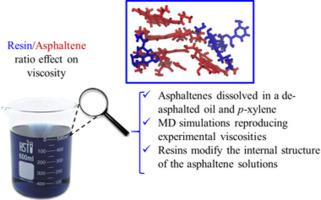Journal of Molecular Liquids ( IF 5.3 ) Pub Date : 2020-07-06 , DOI: 10.1016/j.molliq.2020.113754 Ivan Moncayo-Riascos , Esteban Taborda , Bibian A. Hoyos , Camilo A. Franco , Farid B. Cortés

|
This study focuses on understanding the effect of the resin/asphaltene mass ratio (R/A) on the rheological behavior of asphaltene solutions. To this aim, two cases were evaluated experimentally and theoretically. The first case comprised asphaltenes dissolved in a de-asphalted oil (DAO) at asphaltene concentrations of 2, 10, and 16.5% of mass fraction, with R/A ratios of 3, 6, and 31 being obtained. The second case consisted of asphaltenes dissolved in p-xylene, at an asphaltene mass fraction of 1 and 18%, and adding resins to obtain low R/A ratios (0, 0.125, 0.5, 1, and 1.5). The viscosities measured experimentally were reproduced by molecular dynamics (MD) simulations, using the Green-Kubo method and non-equilibrium MD (NEMD) for estimating the viscosity of solutions with Newtonian and non-Newtonian behavior, respectively. In all cases, the experimental measurements were accurately reproduced by MD. Further, the asphaltene-asphaltene and asphaltene-resin coordination number (CN), the asphaltene-asphaltene and asphaltene-solvent interaction energies, the radius of gyration, and the volumetric fraction for asphaltene aggregates were calculated. Theoretical results evidence that the asphaltene molecules dissolved in DAO exhibited repulsive interaction energies between them, whereby the asphaltene is mainly dispersed for R/A ratios higher than 3 in DAO. This result indicates that the viscosity of the heavy oil is not only dependent on the asphaltene aggregation, but that the resin plays a key role in the rheological behavior of this type of crude oil. This latter suggestion was evidenced in the viscosity measurements due to the DAO viscosity (1776 cP) being considerably higher compared to the individual viscosity of the other compounds of the mixture (i.e., saturates and aromatics), which were at least two orders of magnitude lower. In the experimental evaluations of rheological behavior, varying the resin amount in asphaltene dissolved in p-xylene, a minimum viscosity point was obtained for a specific R/A ratio. The MD results indicated that the resins inhibit the asphaltene aggregation, reducing the volumetric fraction and, therefore, the viscosity decreased. Understanding the physical principles of the effect of the resin on the asphaltenes' aggregation, from an atomistic point of view, is a valuable contribution for designing inhibitors that can be used for the specific molecular characteristics of any crude oil.
中文翻译:

树脂/沥青质比对沥青质溶液在脱沥青油和对二甲苯中流变行为的影响:理论-实验方法
这项研究的重点是了解树脂/沥青质质量比(R / A)对沥青质溶液流变行为的影响。为此,在实验和理论上对两个案例进行了评估。第一种情况包括以2、10和16.5质量%的沥青质浓度溶解在脱沥青油(DAO)中的沥青质,R / A比为3、6和31。由沥青质的第二种情况下溶解在p-以二甲苯的质量分数为1和18%的比例合成-二甲苯,并添加树脂以获得低的R / A比(0、0.125、0.5、1和1.5)。实验测得的粘度通过分子动力学(MD)模拟重现,分别使用Green-Kubo方法和非平衡MD(NEMD)来估计具有牛顿和非牛顿行为的溶液的粘度。在所有情况下,MD均精确再现了实验测量值。此外,计算了沥青质-沥青质和沥青质-树脂的配位数(CN),沥青质-沥青质和沥青质-溶剂的相互作用能,回转半径和沥青质骨料的体积分数。理论结果表明,溶解在DAO中的沥青质分子之间具有排斥相互作用能,因此,沥青质主要在DAO中以高于3的R / A比分散。该结果表明,重油的粘度不仅取决于沥青质的聚集,而且树脂在这类原油的流变行为中起关键作用。后一种建议在粘度测量中得到了证明,这是由于DAO粘度(1776 cP)与混合物中其他化合物(即饱和和芳族化合物)的单独粘度相比要低得多,后者至少低两个数量级。 。在流变行为的实验评估中,改变溶解在沥青质中的沥青质中的树脂量 但该树脂在这类原油的流变行为中起着关键作用。后一种建议在粘度测量中得到了证明,这是由于DAO粘度(1776 cP)比混合物中其他化合物(即饱和和芳族化合物)的单独粘度要高得多,后者至少低了两个数量级。 。在流变行为的实验评估中,改变溶解在沥青质中的沥青质中的树脂量 但该树脂在这类原油的流变行为中起着关键作用。后一种建议在粘度测量中得到了证明,这是由于DAO粘度(1776 cP)与混合物中其他化合物(即饱和和芳族化合物)的单独粘度相比要低得多,后者至少低两个数量级。 。在流变行为的实验评估中,改变溶解在沥青质中的沥青质中的树脂量对-二甲苯,对于特定的R / A比,获得了最小粘度点。MD结果表明,树脂抑制沥青质聚集,降低了体积分数,因此粘度降低。从原子学角度理解树脂对沥青质聚集的影响的物理原理,对于设计可用于任何原油特定分子特性的抑制剂具有重要的贡献。











































 京公网安备 11010802027423号
京公网安备 11010802027423号